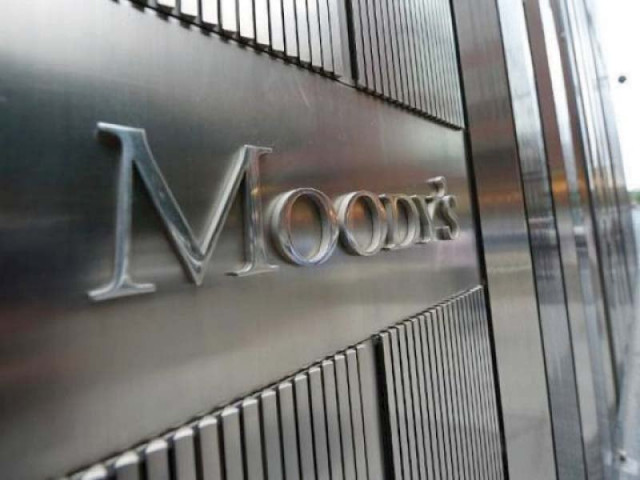Currency could weaken to Rs125 to the dollar: Moody’s
Moody's says Pakistan’s susceptibility to event risk also ‘high’, driven by domestic and geopolitical risk

Moody’s said that a moderate but rising level of external government debt also exposes the country’s finances to sharp currency depreciations. PHOTO: FILE
In its latest report, ‘Government of Pakistan - B3 stable, annual credit analysis’, Moody’s has taken a negative view of Pakistan’s external sector but remained upbeat about economic growth prospects due to the China-Pakistan Economic Corridor (CPEC).
The credit ratings agency also does not see any “significant surprises” in terms of the broader direction of macroeconomic and national security policies after the 2018 general elections, indicating towards limited options available to political parties to change the landscape.
It has forecasted that as against Rs116 to a dollar value by June this year, the nominal exchange rate could be Rs125 to a dollar by June 2019, implying a devaluation of 7.75%. The local currency has remained under pressure in recent months due to mounting external sector financing requirements. The government has already devalued the currency by over 10% from December to March of this fiscal year.
Moody’s said that a moderate but rising level of external government debt also exposes the country’s finances to sharp currency depreciations. The high level of imports, largely because of CPEC, continues to exert pressure on the external account, it added.
It said that there are also risks of higher than expected inflation, as oil prices have continued to rise, and there may be further rounds of currency depreciation by the SBP to reduce import demand.
The ratings agency also expects “ongoing pressure on Pakistan’s foreign exchange reserves, arising from the country’s large refinancing needs and its widening current account deficit”. Foreign exchange reserves fell to $10.7 billion. The import cover of foreign exchange reserves has consequently fallen to less than 2.5 months, which is below the IMF’s recommended minimum adequacy level of three months, it added.
The moderately large and rising share of foreign currency borrowing further exposes the sovereign credit profile to sharp currency depreciations, warned Moody’s. The increase in government’s debt burden since fiscal 2016 has been due to higher external debt, borrowed partly to fund the country’s balance of payments deficit. It noted that the external debt as percentage of official foreign currency reserves has risen to 730.4%, which is the highest level in past two years.
The Moody’s has included growing debt burden among credit rating challenges, which has weakened the country’s debt bearing capacity. “Pakistan’s debt affordability is one of the weakest among B-rated sovereigns with narrow tax bases”, stated the credit rating agency.
At 68.1% of GDP as of fiscal 2017, the government’s debt stock is higher than the 57.5% median for B-rated sovereigns. Moody’s said that Pakistan will not adhere to Fiscal Responsibility and Debt Limitation (FRDL) Act for at least next three years. The Act requires the government to limit public debt to 60% of GDP until fiscal 2018 and targets a further reduction to 50% of GDP over the following 15 years.
Govt uses ‘best tool in hand’, allows rupee fall
The credit rating agency has also set Pakistan’s government liquidity risk is “high” due to sizable fiscal deficits and reliance on short-term debt. At an estimated 33.4% of GDP, Pakistan’s gross borrowing requirement in fiscal year 2018 is the fourth largest among all rated sovereigns, after Japan, Egypt and Bahrain, and higher than most similarly rated peers. It has assessed Pakistan’s susceptibility to event risk also “high”, driven by domestic and geopolitical political risk, and government liquidity risk, stemming from the government’s large rollover requirements.
Govt injected $7b to keep rupee overvalued in recent years
Pakistan’s political risk is also assessed “high”, reflecting a strong probability of an escalation of violent terrorism or tensions between the different branches of the government, which would threaten political stability and divert essential policy and economic resources.
Moody’s said that successful implementation of the CPEC project has the potential to transform the Pakistani economy by removing infrastructure bottlenecks and stimulating both foreign and domestic investment. But “the fiscal costs related to the project could raise Pakistan’s debt burden more rapidly and significantly than we expect, and persistently high levels of imports could develop into greater external vulnerability”.
Need to study medium-term effects of rupee devaluation
Moody’s said that over the next three to five years, CPEC has the potential to significantly improve Pakistan’s competitiveness and raise potential GDP growth, by relieving supply-side constraints and catalyzing private sector investment. But it said that the CPEC implementation could be slower than envisaged or less effective at generating productivity gains.
Published in The Express Tribune, May 22nd, 2018.
Like Business on Facebook, follow @TribuneBiz on Twitter to stay informed and join in the conversation.



















COMMENTS
Comments are moderated and generally will be posted if they are on-topic and not abusive.
For more information, please see our Comments FAQ